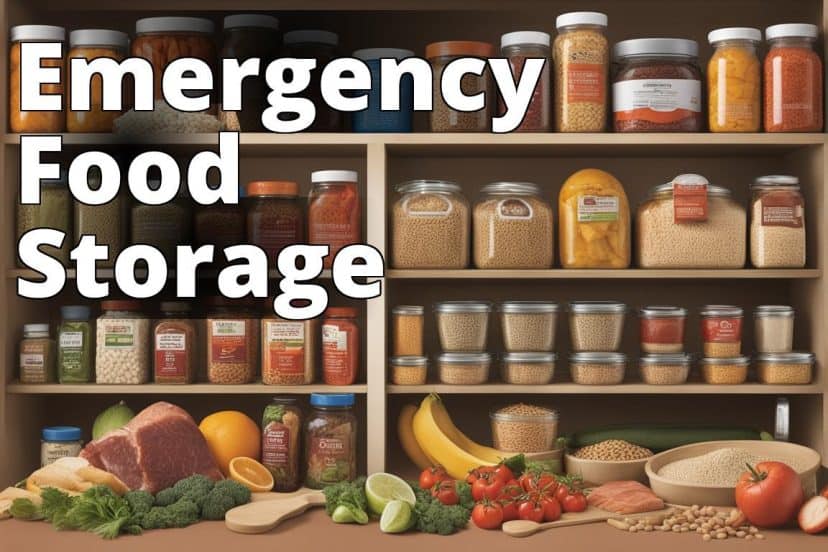9 Benefits of Dehydrated Food for Emergencies
Essential Guide to Emergency Preparedness: Unlocking the Power of Dehydrated Food
When it comes to emergency preparedness, having a reliable source of food is essential. Dehydrated food has emerged as a popular choice for emergency situations due to its many benefits.
Whether you are preparing for natural disasters, camping trips, or simply looking for a convenient and long-lasting food option, dehydrated food is a smart choice.
In this article, we will explore the role of dehydrated foods in emergency preparedness and discuss nine key benefits they offer.

Role of Dehydrated Foods in Emergencies
By reading this article, you will learn:
– Dehydrated food benefits in emergency preparedness.
– How to use, prepare, store, and rehydrate dehydrated food.
– The best dehydrated foods for emergencies.
What is Dehydrated Food?
Dehydrated food is food that has had the majority of its moisture content removed through a drying process. This process involves removing water from the food, which helps to inhibit the growth of bacteria, yeasts, and molds that can cause spoilage.
Dehydrated food is lightweight, compact, and retains its nutritional value, making it an ideal option for emergencies.

9 Benefits of Dehydrated Food for Emergencies
1. Lightweight and Compact
One of the primary advantages of dehydrated food is its lightweight and compact nature. When you remove the moisture from food, it significantly reduces its weight and volume.
This makes dehydrated food much easier to transport, especially in emergency situations where you may need to carry your food supply for long distances.
Additionally, the compact size of dehydrated food allows for efficient storage, saving valuable space in your emergency kit or pantry.
2. Long Shelf Life
Dehydrated food has an impressively long shelf life compared to its fresh counterparts. By removing moisture, the growth of bacteria, yeasts, and molds is inhibited, which helps to extend the food’s shelf life.
In fact, properly dehydrated food can last for months or even years if stored correctly. This makes it an excellent option for emergency preparedness, as you can stock up on dehydrated food well in advance and have peace of mind knowing that it will be safe to consume when needed.

Insider Tip: “When selecting dehydrated food for emergencies, look for products that have been specifically designed and packaged for long-term storage. These products often have an extended shelf life and are packed in airtight containers to preserve the food’s freshness.” (source)
3. Retains Nutritional Value
Contrary to popular belief, dehydrated food retains a significant amount of its nutritional value. While the drying process does cause some nutrient loss, many essential vitamins, minerals, and antioxidants remain intact. In fact, dehydrated fruits and vegetables can sometimes have higher nutrient concentrations than fresh produce due to the removal of water. This makes dehydrated food a practical choice for emergencies, as it can provide you with the necessary nutrients to sustain yourself during challenging times.
4. Easy to Prepare
Preparing dehydrated food is incredibly simple, which is especially valuable in emergency situations where time and resources may be limited. Most dehydrated meals only require adding hot water or rehydrating the food in a liquid of your choice.
Within minutes, you can have a nutritious and satisfying meal ready to eat. This convenience makes dehydrated food an excellent option for emergencies, as it allows you to quickly and easily nourish yourself or your family when needed.
5. Saves Money
Investing in dehydrated food for your emergency preparedness plan can actually save you money in the long run.
While the upfront cost of dehydrated food may be higher than purchasing fresh produce, the long shelf life of dehydrated food means that you won’t have to constantly restock your emergency supplies.
Additionally, dehydrated food helps to minimize food waste since it has an extended shelf life. By reducing the amount of food that goes to waste, you can save money on your overall food expenses.
6. Reduces Waste
Food waste is a significant global issue, and dehydrated food can help combat this problem. When you dehydrate food, you remove the moisture content, which inhibits the growth of bacteria and other microorganisms that cause spoilage.
This means that dehydrated food has a much longer shelf life compared to fresh produce, reducing the likelihood of food waste. By incorporating dehydrated food into your emergency preparedness plan, you can minimize waste and ensure that your food supply remains usable for an extended period.
7. Versatile
Dehydrated food offers a wide range of options, making it a versatile choice for emergency preparedness. You can find dehydrated fruits, vegetables, meats, grains, and even complete meals.
This variety allows you to create well-rounded and nutritious meals during emergencies, ensuring that you have a balanced diet. Whether you prefer vegetarian options or need a high-protein meal, dehydrated food offers something for everyone.
8. Tastes Great
One common misconception about dehydrated food is that it lacks flavor. However, with advancements in food preservation technology, dehydrated food now offers excellent taste and quality.
Many dehydrated meals are created using high-quality ingredients and flavorful seasonings to ensure a satisfying dining experience.
Whether you are enjoying a dehydrated fruit snack or a complete dehydrated meal, you can expect delicious flavors that rival fresh alternatives.
9. Easy to Store
Storing dehydrated food is a breeze, making it an ideal option for emergency preparedness. Unlike fresh produce, which requires refrigeration or freezing, dehydrated food can be stored at room temperature.
This eliminates the need for special storage conditions and allows you to keep your emergency food supply in a variety of locations, such as your pantry, basement, or even a storage unit.
The ease of storage ensures that you can maintain a reliable food supply without the need for complicated preservation methods.
How to Use Dehydrated Food in Your Emergency Preparedness Plan
Now that you understand the benefits of dehydrated food for emergencies, it’s essential to know how to incorporate it into your emergency preparedness plan effectively. Here are a few tips to help you make the most of dehydrated food in emergency situations:
- Plan your meals: Before an emergency occurs, take the time to plan out your meals using dehydrated food. This will help you ensure that you have a well-rounded and nutritious diet during challenging times.
- Practice rehydrating: Familiarize yourself with the process of rehydrating dehydrated food before an emergency happens. This will allow you to understand the time and water requirements for different types of food.
- Rotate your stock: While dehydrated food has a long shelf life, it’s essential to regularly check and rotate your stock. This will help ensure that you always have fresh and usable food available when you need it.
Insider Tip: “Consider creating a meal plan and practicing cooking with dehydrated food during non-emergency situations.
This will give you an opportunity to experiment with different recipes and get a feel for how the food rehydrates and tastes.” (source)
How to Dehydrate Food at Home
If you want to take your emergency preparedness to the next level, you can even dehydrate your own food at home.
Dehydrating food allows you to have complete control over the ingredients, flavors, and textures of your dehydrated meals. Here’s a simple guide to dehydrating food at home:
- Choose your food: Select fruits, vegetables, meats, or herbs that you want to dehydrate. Ensure that the produce is fresh and free from any signs of spoilage.
- Prepare the food: Wash and slice the food into uniform pieces. This will help ensure that the food dehydrates evenly.
- Pre-treat if necessary: Some foods, such as apples or potatoes, may require pre-treatment to prevent browning. This can be done by dipping the food in lemon juice or a solution of water and ascorbic acid.
- Dehydrate the food: Place the food on dehydrator trays or baking sheets and set the dehydrator or oven to the appropriate temperature. The drying time will vary depending on the type of food and the drying method used.
- Store the dehydrated food: Once the food is completely dry, allow it to cool before storing it in airtight containers. Store the containers in a cool, dark place for maximum shelf life.
Insider Tip: “When dehydrating food at home, it’s important to follow proper food safety guidelines. Ensure that your dehydrator or oven reaches the recommended temperature to kill any harmful bacteria.” (source)
What Foods Can Be Dehydrated?
The range of foods that can be dehydrated is vast, allowing you to create a diverse and nutritious emergency food supply. Here are some examples of foods that can be easily dehydrated:
Fruits and Vegetables
- Apples
- Bananas
- Strawberries
- Tomatoes
- Carrots
- Peppers
Meats and Proteins
- Beef jerky
- Chicken
- Turkey
- Tofu
- Lentils
- Black beans
Grains and Legumes
- Rice
- Quinoa
- Pasta
- Oats
- Chickpeas
- Kidney beans
Case Study: Sarah’s Emergency Preparedness Plan
Sarah, a single mother of two, understands the importance of being prepared for emergencies. She lives in an area prone to natural disasters and wants to ensure the safety and well-being of her family.
Sarah decides to incorporate dehydrated food into her emergency preparedness plan and experiences the benefits firsthand.
Long Shelf Life
When Sarah first heard about dehydrated food, she was skeptical about its shelf life. However, after conducting her research, she discovered that dehydrated food can last for years when stored properly.
This knowledge gave her peace of mind, knowing that she could stock up on dehydrated food and have it readily available when needed.
Lightweight and Compact
Sarah’s emergency kit needed to be portable and easy to carry. She realized that dehydrated food was lightweight and compact, making it the perfect addition to her emergency bag.
With limited space, she could pack a significant amount of dehydrated food without it weighing her down.
Nutritional Value
As a health-conscious mother, Sarah was concerned about the nutritional value of dehydrated food. She was pleasantly surprised to learn that the dehydration process preserves most of the nutrients in the food.
This meant that even during an emergency, her family would still have access to essential vitamins and minerals.
Versatility
One of the main benefits Sarah found with dehydrated food was its versatility. She could use dehydrated fruits and vegetables in a variety of ways – as snacks, in soups, or even rehydrated and added to meals.
This flexibility allowed her to create nutritious and satisfying meals for her family, even in challenging situations.
Sarah’s experience with dehydrated food in her emergency preparedness plan has been a game-changer.
She feels confident that she can provide for her family during emergencies, knowing that she has a reliable source of food that is lightweight, long-lasting, and nutritious.
How to Store Dehydrated Food
Proper storage is crucial for maintaining the quality and shelf life of dehydrated food. Here are some tips for storing dehydrated food:
- Choose the right containers: Use airtight containers such as mason jars, vacuum-sealed bags, or Mylar bags with oxygen absorbers. These containers will help keep moisture and oxygen out, preserving the food’s quality.
- Keep it cool and dry: Store the containers in a cool, dark place away from direct sunlight, heat sources, and moisture. Optimal storage temperatures range from 50 to 70 degrees Fahrenheit (10 to 21 degrees Celsius).
- Label and date: Properly label each container with the contents and the date of dehydration. This will help you keep track of the freshness and rotation of your dehydrated food supply.
How to Rehydrate Dehydrated Food
Rehydrating dehydrated food is a simple process that requires adding liquid to the food and allowing it to absorb the moisture. Here’s how to rehydrate dehydrated food:
- Measure the food: Determine the desired amount of food you want to rehydrate and measure it accordingly.
- Choose the liquid: Depending on the recipe or personal preference, you can use hot water, broth, juice, or even milk as the rehydrating liquid.
- Add the liquid: Pour the liquid over the dehydrated food, ensuring that it is fully submerged.
- Allow time for rehydration: The time required for rehydration will vary depending on the type of food and the desired texture. Most dehydrated fruits and vegetables will rehydrate within 10 to 15 minutes, while meats and grains may take longer.
- Drain excess liquid: Once the food is fully rehydrated, drain any excess liquid before using it in your recipe or enjoying it as a snack.
Insider Tip: “To enhance the flavor of rehydrated food, consider adding spices, herbs, or seasoning blends during the rehydration process. This will infuse the food with additional taste and make it even more enjoyable.” (source)
The Best Dehydrated Foods for Emergencies
While there are numerous options for dehydrated foods, some choices stand out as particularly well-suited for emergencies. Here are a few examples:
Fruits and Vegetables
- Dehydrated apples: These are a great source of fiber and vitamin C, providing a nutritious and tasty snack during emergencies.
- Dehydrated tomatoes: Packed with antioxidants and vitamins, dehydrated tomatoes can be used in a variety of meals, such as pasta sauces or soups.
Meats and Proteins
- Beef jerky: A classic choice for emergency protein, beef jerky offers a long shelf life and is a convenient source of energy.
- Dehydrated chicken: Chicken is a versatile protein source that can be rehydrated and used in various recipes, from stir-fries to casseroles.
Grains and Legumes
- Dehydrated rice: Rice is a staple in many households and provides a good source of carbohydrates for energy during emergencies.
- Dehydrated lentils: Rich in protein and fiber, dehydrated lentils offer a nutritious option for soups, stews, and salads.
By incorporating these dehydrated foods into your emergency preparedness plan, you can ensure that you have a well-rounded and sustainable food supply during challenging times.
In conclusion, dehydrated food plays a vital role in emergency preparedness. Its lightweight and compact nature, long shelf life, retention of nutritional value, ease of preparation, cost-saving benefits, waste reduction, versatility, great taste, and easy storage make it an excellent choice for emergencies.
By understanding how to use dehydrated food effectively, including how to dehydrate and rehydrate food, and knowing the best dehydrated foods for emergencies, you can create a reliable and sustainable emergency food supply. So, stock up on dehydrated food and be prepared for whatever emergencies may come your way.
FAQs
Who benefits from dehydrated foods in emergency preparedness?
Dehydrated foods benefit anyone preparing for emergencies, such as hikers, campers, and those prepping for natural disasters.
What makes dehydrated foods important for emergency preparedness?
Dehydrated foods are important for emergency preparedness because they have a long shelf life and retain their nutrients.
How can one use dehydrated foods in emergency preparedness?
Dehydrated foods can be rehydrated with water and used in a variety of recipes, making them versatile for emergency meal planning.
What if I have dietary restrictions or allergies?
There are a variety of dehydrated foods available, including options for gluten-free, dairy-free, and other dietary restrictions.
How do I know which dehydrated foods to stock up on?
When choosing dehydrated foods for emergency preparedness, consider nutritional content, shelf life, and personal preferences.




